Archive for the ‘Book Reviews’ Category
Sunday, August 7th, 2022
Anyone can write but editing must be learned. Some books that helped me learn to edit:
Self Editing For Fiction Writers by Renni Browne and Dave King teaches style, dialogue, point of view, ‘show not tell’, character.
The Art of Writing by John Gardner talks about maintaining the ‘dream’ of the story – when the writing draws attention to itself (in a bad way) then the dream is broken for the reader.
Go over and over it…refusing to let anything stay if it looks awkward, phony, or forced.– John Gardner
On Becoming a Writer by Dorothea Brande (1934) suggests a writer begins with the unconscious mind ‘but then the conscious mind ‘must control, combine and discriminate’. That’s editing in a nutshell.
The writer must be as God in his universe — present everywhere and visible nowhere. -Flaubert
Tags: books, editing, writing
Posted in Book Reviews, Writing | No Comments »
Sunday, July 10th, 2022
“The idea of the extraordinary happening in the context of the ordinary is what’s fascinating to me.” – Chris van Allsburg
Picture books by Chris van Allsburg are not only beautifully illustrated, the stories are wide open for wide interpretation, which makes them ideal for children. It’s impossible to look at the pictures in Harris Burdick without imagining a story. My other surreal favourites are Bad Day at Riverbend, about a black and white cowboy town attacked by colourful crayons – and The Wretched Stone, about a strange glowing stone which makes the people regress intellectually (TV and digital screens perhaps?).
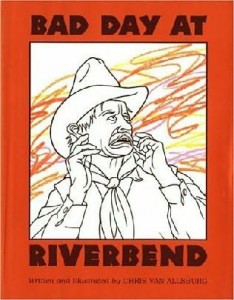
Tags: books, children's books, picture books, reviews
Posted in Book Reviews, Children's Books | No Comments »
Sunday, August 8th, 2021
The Little Prince (1943) by Antoine de Saint-Exupéry is a fable about a pilot who crashes in the desert and meets a wise child. It’s one of the world’s most translated books (in 250 languages) and it has parhaps the most intriguing sentence in all of children’s literature:
What is essential is invisible to the eyes.
What is ‘essential’? Is it truth, love, spirit, mystery? These are the questions the story evokes. Saint-Exupéry was a pilot who also wrote great adventure books (eg. Wind, Sand and Stars ).
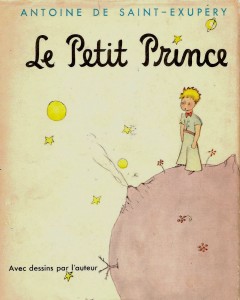
Tags: children's books, consciousness, reviews
Posted in Book Reviews, Children's Books | No Comments »
Thursday, March 11th, 2021
Fiction should be both canny and uncanny. – Flannery O’Connor
One of my favourite short stories is Flannery O’Connor’s A Good Man Is Hard To Find – it certainly has a powerful ending. Her stories can be dark but there’s always a redemptive thread in them. O’Connor wrote despite the pain of lupus which ended her life at the age of 39. Here are some of her thoughts about the writing process (from Mystery and Manners):
If you want to write well and live well at the same time, you’d better arrange to inherit money.
When I sit down to write, a monstrous reader looms up who sits down beside me and continually mutters, ‘I don’t get it, I don’t see it, I don’t want it.’
Fiction is about everything human and we are made of dust, and if you scorn getting dusty, then you shouldn’t write fiction.
There’s a certain grain of stupidity that the fiction writer can hardly do without and this is the quality of having to stare, of not getting to the point at once.
The artist uses her reason to discover an answering reason in everything she sees.
The writer has to judge himself with a stranger’s eye and a stranger’s severity.
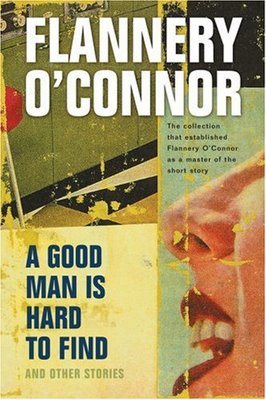
Tags: books, reviews, writers
Posted in Book Reviews, Writing | No Comments »
Sunday, July 26th, 2020
When truly present in nature, we use all our senses at the same time, which is the optimum state of learning. ― Richard Louv, The Nature Principle
Direct exposure to the natural world is essential for healthy childhood development. Forest schools are springing up all over the world to give children outdoor experiences. I’m a trustee for a new Nature School (in Dunedin, New Zealand) which combines creative play with skill-teaching (bushcraft, beekeeping etc).
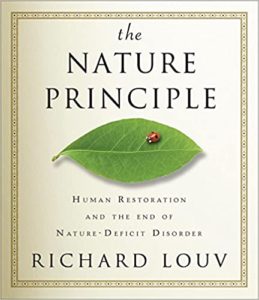
Tags: books, connections, reviews
Posted in Book Reviews | No Comments »
Friday, May 29th, 2020
Tony Juniper’s book What Has Nature Ever Done For Us? brilliantly proves that money really does grow on trees. Nature is the basis of our economic lives and is worth $100 trillion/year to the global economy. But we use up our yearly budget of resources in about 8 months and after that we are destroying our natural capital. Juniper lists the huge benefits we get from healthy soil, plants, light, clean water, and animals, and shows it makes economic sense to care for them and respect them. Pollinators, for example, are vital for our food supply: of the 100 most important food crop plants, 71 are pollinated by bees. Juniper is hopeful we can protect the bees, for example, by planting ‘bee roads’ of flowering plants between our crops.
Everyone who has even a small garden can help with this.
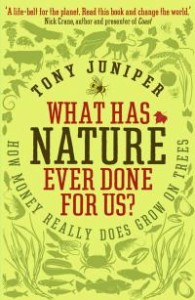
Posted in Book Reviews, Gardening, Science | No Comments »
Saturday, May 2nd, 2020
There is a kind of library in the cells of your body. Inside each cell are tiny molecules which are digesting, healing, sensing, supporting and energising you. Most of this is done by protein molecules – there are 60,000 different proteins in the body; such as enzymes (for chemical reactions) and hormones (to send messages). We make proteins when we need them (eg. we build antibodies when we’re attacked by viruses). In his wonderful book, Our Molecular Nature, David Goodsell writes about proteins:
We must be able to build each one exactly when and where it is needed, using only the materials available in the diet.
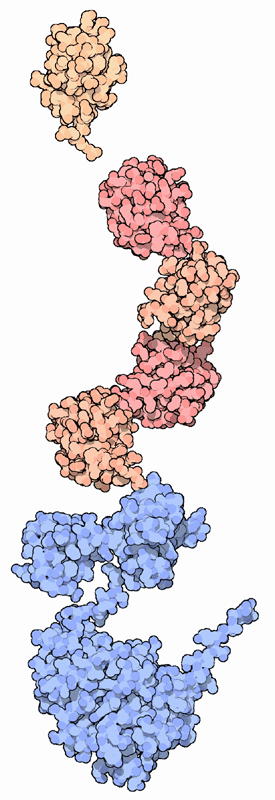 This process is accurate because each cell has a ‘library’ inside it (called DNA) which contains the instructions to build the molecules. This amazing library is used every second of your life. DNA has 6 billion bits of information – about the number of books in a big library.
This process is accurate because each cell has a ‘library’ inside it (called DNA) which contains the instructions to build the molecules. This amazing library is used every second of your life. DNA has 6 billion bits of information – about the number of books in a big library.
Ultimately, a single cell, when paired with an appropriate mate, can build an entirely new human being, molecule by molecule.
Using this blueprint, proteins are built in chains from smaller molecules called amino acids. Like letters of an alphabet, there are only 20 amino acids arranged to create thousands of different proteins. Some proteins last a long time, others are disassembled after a few minutes. (This allows the body to respond rapidly). The illustration shows ubiquitin, a protein found throughout your body. Ubiquitin’s job is to mark proteins for destruction.
David Goodsell is a scientist and molecular artist. View his art here and learn more about proteins here.
Illustration of Ubiquitin © David S. Goodsell, the Scripps Research Institute.
Posted in Book Reviews, Science | No Comments »
Saturday, February 1st, 2020
There is only one time that is important: Now. – Tolstoy
The wisdom in Tolstoy’s Twenty-Three Tales (1903) always inspires me. These classic folk tales include: How Much Land Does a Man Need? (very little, it turns out); The Three Questions (eg. What should I do with my time?); and A Grain as Big as a Hen’s Egg (the power of organic gardening).
Photo (1908): Tolstoy aged 80
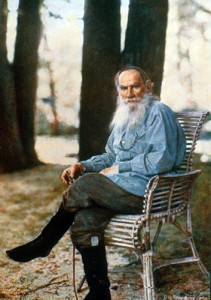
Tags: books, reviews, short stories, Tolstoy
Posted in Book Reviews | No Comments »
Saturday, November 30th, 2019
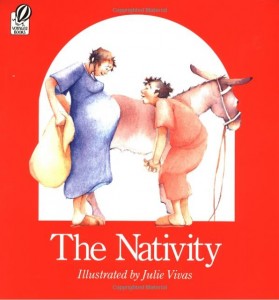 The Nativity, illustrated by Julie Vivas, is my favourite children’s Christmas book. The pictures convey the humanity of the story by showing the love between Mary and Joseph, the pregnancy and birth, within a rustic setting. Oddly, it all sits well with the poetic language of the 17th century King James version of the Bible. Vivas also illustrated the wonderful book for babies, I Went Walking.
The Nativity, illustrated by Julie Vivas, is my favourite children’s Christmas book. The pictures convey the humanity of the story by showing the love between Mary and Joseph, the pregnancy and birth, within a rustic setting. Oddly, it all sits well with the poetic language of the 17th century King James version of the Bible. Vivas also illustrated the wonderful book for babies, I Went Walking.
Tags: children's books, picture books, reviews
Posted in Book Reviews, Children's Books | No Comments »
Saturday, August 31st, 2019
Dae they no ken that Tintin’s in danger?
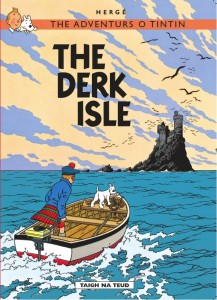 The Derk Isle is the first Tintin book to be translated into the Scots language (which is over 1000 years old and is still spoken) and it works a wee treat. Familiarity with the original, The Black Island (1938), adds to the fun but most readers will easily understand the Scots (it’s best read aloud). Among the delightful phrases: ‘dinna fash’ (don’t worry), ‘whit a scunner’ (what a nuisance), and ‘blackbelickit’ (drat). Snowy becomes Tarrie (terrier) and the Thompson twins are Nesbit and Nesbit.
The Derk Isle is the first Tintin book to be translated into the Scots language (which is over 1000 years old and is still spoken) and it works a wee treat. Familiarity with the original, The Black Island (1938), adds to the fun but most readers will easily understand the Scots (it’s best read aloud). Among the delightful phrases: ‘dinna fash’ (don’t worry), ‘whit a scunner’ (what a nuisance), and ‘blackbelickit’ (drat). Snowy becomes Tarrie (terrier) and the Thompson twins are Nesbit and Nesbit.
“He’s a fair wunner, is wee Tarrie. There’s no a dug like him for snowkin efter crooks!”
“Oot ye get! An nae joukery-pawkery, mind!”
Tags: children's books, comics, Tintin
Posted in Book Reviews, Children's Books | No Comments »
Saturday, August 3rd, 2019
Twenty-Three Tales by Tolstoy
There is only one time that is important – Now! It is the most important time because it is the only time when we have any power.
Moominpappa at Sea by Tove Jansson
Moominpappa had no idea what to do with himself, because it seemed everything there was to be done had already been done.
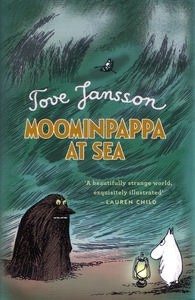
The Wisdom of Insecurity by Alan Watts
If the universe is meaningless, so is the statement that it is so.
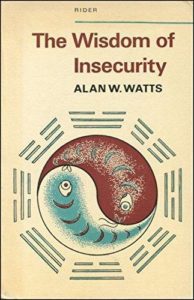
Right Ho, Jeeves by P.G. Wodehouse
I wouldn’t have said off-hand that I had a subconscious mind, but I suppose I must without knowing it, and no doubt it was there, sweating away diligently at the old stand, all the while the corporeal Wooster was getting his eight hours.
The Golden Apples of the Sun by Ray Bradbury
And pluck till time and times are done
The silver apples of the moon,
The golden apples of the sun.
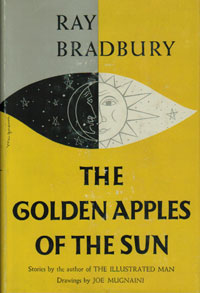
Tags: books, Ray Bradbury, reviews, Tolstoy
Posted in Book Reviews, Reading | 2 Comments »
Saturday, June 1st, 2019
Far from being a means to escape the social world, reading stories can actually improve your social skills by helping you better understand other human beings. – Keith Oatley (The Psychology of Fiction)
That master of imagination, J.R.R. Tolkien, said that fantasy “offers not an escape away from reality, but an escape to a heightened reality”. When we read any fiction we enter an imaginary world, but it’s the characters that we attach to most of all. When our emotions are triggered by the characters, that’s when we get an understanding of real life relationships. Children develop empathy for others from about 4 years old – and hearing and reading fiction enables them to walk in another’s shoes. Another great reason for reading to children!
While reading, we can leave our own consciousness, and pass over into the consciousness of another person, another age, another culture. – Maryanne Wolf
Picture from a book about feelings: Bravo by Philip Waechter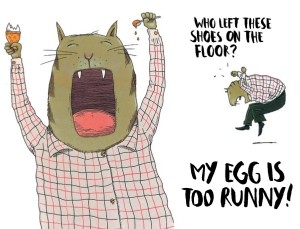
Tags: brain, Reading, tolkien
Posted in Book Reviews, Children's Books, Reading, Science | No Comments »
Friday, March 1st, 2019
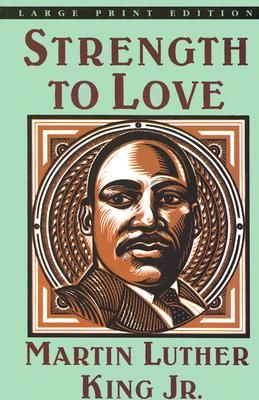 Martin Luther King Jr.’s, Strength To Love, was written during the Civil Rights struggle in the early 1960s. King’s stirring style was aimed at a live church audience and you can almost hear the “Amens” after some sentences. Many of his political statements were censored by the publisher at the time, but almost 60 years later his words remain powerful and relevant. King encourages people to be forgiving, non-violent, non-conformists; and to confront militarism and inequality in society.
Martin Luther King Jr.’s, Strength To Love, was written during the Civil Rights struggle in the early 1960s. King’s stirring style was aimed at a live church audience and you can almost hear the “Amens” after some sentences. Many of his political statements were censored by the publisher at the time, but almost 60 years later his words remain powerful and relevant. King encourages people to be forgiving, non-violent, non-conformists; and to confront militarism and inequality in society.
Our scientific power has outrun our spiritual power. We have learned to fly the air like birds and swim the sea like fish, but we have not learned the simple art of living together.
Expenditures for defence have risen to mountainous proportions. The nations have believed that greater armaments will cast out fear, but they have produced greater fear.
Through non-violent resistance we shall be able to oppose the unjust system and at the same time love the perpetrators of the system. Hate cannot drive out hate, only love can do that.
Capitalism must undergo continual change if our great national wealth is to be more equitably distributed.
All life is interrelated. I can never be what I ought to be until you are what you ought to be.
Tags: martin luther king, Peace, people power, political change, reviews
Posted in Book Reviews, Peace | 1 Comment »
Saturday, February 2nd, 2019
Ferdinand (1936) by Munro Leaf is one of the most influential children’s books because of its simple but powerful theme. The tale of a bull who likes to smell flowers instead of fighting was seen as a pacifist text at the time of the Spanish Civil War.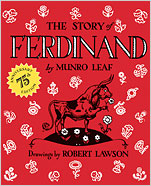 Ferdinand chooses to be himself rather than follow the aggressive crowd. No wonder the book was:
Ferdinand chooses to be himself rather than follow the aggressive crowd. No wonder the book was:
Read the true story of the bull who inspired it: The Marginalian.
Munro Leaf also wrote books which reflected the stricter child-raising style of his time. 3 and 30 Watchbirds (1941) condemns children’s behaviours such as shoe-scuffing, mumbling, moaning, fidgeting, and wasting food. Some of it’s in the spirit of war-time frugality, but some is just plain excessive:
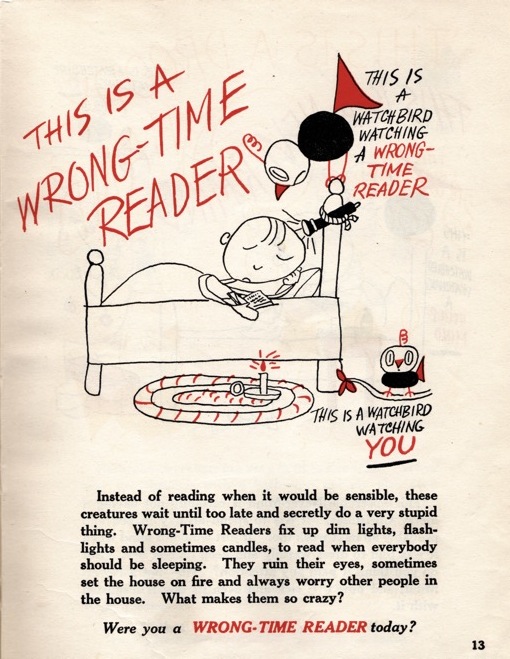
Grammar Can Be Fun is slightly more tongue-in-cheek and warns children against slack language such as “gimme, wanna, gonna, and ain’t”.
Tags: children's books, classics, Peace, picture books
Posted in Book Reviews, Children's Books, Peace | No Comments »
Monday, September 3rd, 2018
Stories tend to get out of hand– Tolkien
Reading Humphrey Carpenter’s wonderful J.R.R. Tolkien – A Biography. The story of his early life and evolution of his stories is fascinating. Some quirky influences on Tolkien’s writing:
- The toddler Tolkien attacked by a terrifying tarantula in South Africa (1895)
- Tolkien’s teacher trained his dog to lick its lips with the command “smakka bagms”
- His fellowship of young writers which is broken by the Great War
- The inspiration of the Kalevala mythology of Finland
- A ‘nasty’ holiday on which he wrote a poem about a slimy cave creature named ‘Glip’
- His friendship with C.S.Lewis, on whom he based Treebeard’s ‘hrooming’ voice
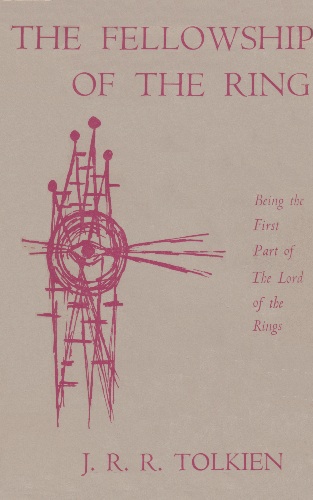
Link to all the Lord of the Rings covers.
Tags: tolkien
Posted in Book Reviews, Children's Books, Writing | No Comments »
Saturday, August 4th, 2018
Iona and Peter Opie were like the Brothers’ Grimm of the 1950s. Their fabulous book was The Lore and Language of Schoolchildren, an epic collection of children’s rhymes, riddles, superstitions, jeers, and customs, garnered from interviews with thousands of English children in the 1950s. Many of these rhymes and tricks persist in the playground today. Here are some gems from the Opie’s collection:
Pinch-me, Punch-me, and Steponmytoes,
Went down to the river to swim,
Two of the three were drowned,
Who do you think was saved?
Old Mr Kelly,
Had a pimple on his belly;
His wife cut it off,
It tasted like jelly.
When the war is over Hitler will be dead,
He hopes to go to heaven with a crown upon his head.
But the Lord said, No! You’ll have to go below,
There’s only room for Churchill, so cheery, cheery oh.
God made the bees
The bees make the honey;
We do the work,
The teacher gets the money.
Scab and matter custard,
Green snot pies,
Dead dog’s giblets
Dead cat’s eyes.
Hard boiled snails, Spread it thick
Wash it down with a cup of cold sick!
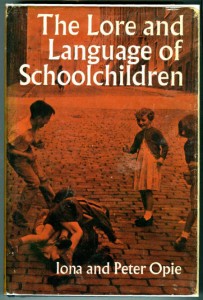
Tags: books, Grimm, poetry, reviews
Posted in Book Reviews, Children's Books | No Comments »
Sunday, July 8th, 2018
It’s really, really heartbreaking. But for some reason you want to read it again and again. It’s an extraordinary love story.– Michael Morpurgo
Almost every Sunday morning as a child I’d listen to Oscar Wilde’s short story, The Happy Prince (1888), on the radio and cry into my pillow so my brother nearby wouldn’t hear. A statue being stripped of his gold to feed the poor seems an unlikely plot for children. I didn’t understand all of Wilde’s lyrical language back then but the story shaped my values concerning wealth, poverty, and authority figures:
“The living always think that gold can make them happy.”
Listen to that radio version read by Robert Morley.
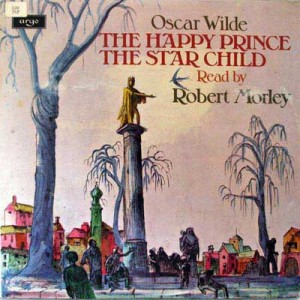
Tags: books, children's books, oscar wilde, reviews
Posted in Book Reviews, Children's Books | No Comments »
Saturday, June 9th, 2018
That touch of reality in a child’s life is a child’s comfort. The child gets the sense that this person who wrote this book knows about me and knows the world can be a troubling, incomprehensible place. Maurice Sendak
Outside Over There is my favourite Maurice Sendak picture book – – nobody else combined the real and the unreal so well. It’s a tale of separation and siblings (that features a creepy ice baby) and is both haunting and comforting. 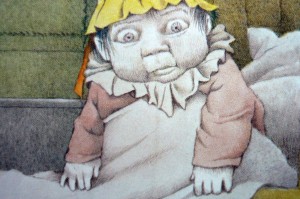
Sendak’s books can be exuberant (In the Night Kitchen), spiritual (Dear Mili), and funny (Pierre, a cautionary tale). I like his vision of atoms dancing to form molecules from the first book he illustrated (when 19 years old), Atomics for the Millions:
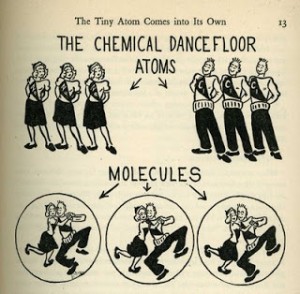
Tags: books, children's books, picture books, reviews
Posted in Book Reviews, Children's Books, Writing | 1 Comment »
Tuesday, August 1st, 2017
Jane Goodall’s memoir, Reason For Hope, is certainly that – her life in an inspiration in difficult times. The book covers her childhood in WW2; her studies of chimpanzees which revolutionised biology; and her development work via the Goodall Institute. The writing is honest and poetic, and I like the way she integrates science with her beliefs (which embrace several traditions). Here’s a link to an interview with Jane Goodall; and quotes from the book:
Each one of us matters, has a role to play, and makes a difference.
We either agree with Macbeth that life is nothing more than a ‘tale told by an idiot’, a purposeless emergence of life-forms…or we believe that, as Teilhard de Chardin put it, ‘There is something afoot in the universe, something that looks like gestation and birth.’
Yes, my child, go out into the world; walk slow
And silent, comprehending all, and by and by
Your soul, the Universe, will know
Itself: the Eternal I.
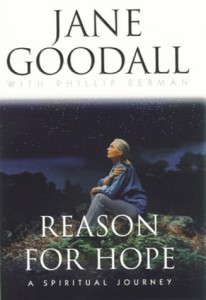
Tags: reviews, science
Posted in Book Reviews, Science | No Comments »
Sunday, June 4th, 2017
Not another pirate picture book! Yes, but a beautifully offbeat one. Captain Slaughterboard Drops Anchor (1939) is a masterpiece of illustration by the artist/novelist Mervyn Peake (author of the intricate Gormenghast trilogy). His pirate Captain has a mid-life crisis on a weird pink island where he discovers ‘a creature as bright as butter’ who inspires him to ‘drop out’ (the creature looks ‘like Bob Dylan with cocker-spaniel ears’ – NY Times.) Peake’s son, Fabian, says his father always wanted to live on an island ‘living a bohemian life free from the pressures of modern society’. See more of Peake’s incredible illustrations.
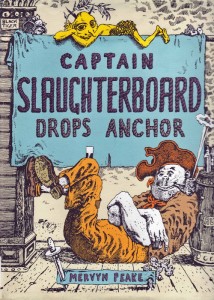
Tags: children's books, picture books
Posted in Book Reviews, Children's Books | No Comments »
Sunday, May 7th, 2017
The Day Boy and the Night Girl (1879) is a fairy tale by George MacDonald about a witch who raises two children in a bizarre experiment – the girl, Nycteris, never sees the sunlight, and the boy, Photogen, never sees the night. The two escape and meet at the twilight hour to help each other overcome their fears of dark and light. It’s an eerie romantic allegory which also subverts male/female fairy tale roles. MacDonald was an unorthodox preacher turned writer whose fantasy tales inspired both Tolkien and C.S. Lewis. My favourite is The Light Princess (1864) a witty story about a feisty princess who has lost her gravity – she floats like a helium balloon and can’t take anything seriously, even a prince who gives up his life for her.
MacDonald occupied a major position in the intellectual life of his Victorian contemporaries. His stories are profoundly experimental and subversive. – (The Complete Fairy Tales of George MacDonald)
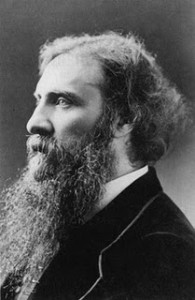
Tags: children's books, fairy tales
Posted in Book Reviews, Children's Books | No Comments »
Sunday, February 5th, 2017
Thoughts from The Importance of Living (1938) by Lin Yutang, Chinese philosopher and inventor.
On writers:
Every word has a life and a personality. A writer always has an instinctive interest in words.
Writing is but the expression of one’s own nature or character… style is not a method, a system or even a decoration; it is but the total impression that the reader gets of the quality of the writer’s mind.
A writer in the ‘familiar’ style speaks in an unbuttoned mood. He completely exposes his weaknesses, and is therefore disarming.
A literary masterpiece is like a stretch of nature itself, well-formed in its formlessness…
On readers:
The ancient peoples called books ‘limp volumes’ and ‘soft volumes’; therefore the best style of reading a book is the leisurely style. In this mood, one develops patience for everything.
I regard the discovery of one’s favourite author as the most critical event in one’s intellectual development. Like a man falling in love with his sweetheart at first sight, everything is right…
A good reader turns an author inside out, like a beggar turning his coat inside out in search of fleas… an itch is a great thing.
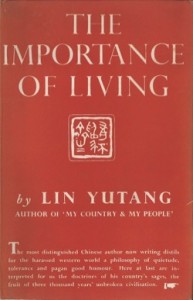
Tags: books, Reading, writing
Posted in Book Reviews, Reading, Writing | No Comments »
Friday, December 16th, 2016
Would it be possible to find a more ungrateful boy, or one with less heart than I have! – Pinocchio
Pinocchio by Carlo Collodi (1882) is a rare thing: an archetypal story for children. The puppet-boy represents every disobedient, lazy child who must face life’s hardships, find parental love and grow up. It can also be read as a Christian allegory, a snapshot of society or as a myth. The language of this classic has barely dated. The best recent version is illustrated by Roberto Innocenti, capturing all the pathos of the tale – his iconic artwork combines painterly detail with cinematic angles. This dark, humourous adventure is a far cry from the sanitized (but beautiful!) Disney movie version.
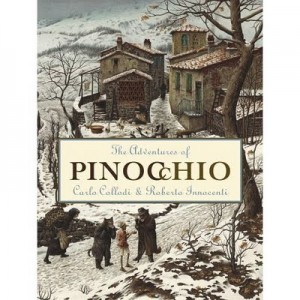
Tags: children's books, picture books, reviews
Posted in Book Reviews, Children's Books | No Comments »
Monday, May 9th, 2016
Gecko Press‘ latest picture book is that rare beast, a message book that also entertains – it’s also artfully designed with eight blank pages and sixty characters! In Don’t Cross the Line by Isabel Minhó Martins, an army general orders a guard to keep the right-hand page of the book blank. But a crowd of people build up on the border, desperately wanting to use the space. What can the guard do? People power succeeds in the end. It’s those eight blank pages that will speak to all ages about freedom: children see an empty space and want to play in it; teenagers ask why it’s forbidden; and adults see the injustice in it. A wonderful concept with lively illustrations by Bernardo Carvalho. (Read about Peace books for children here)
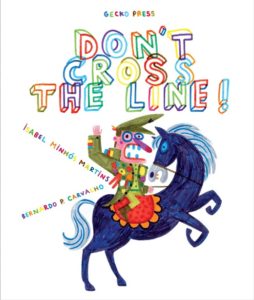
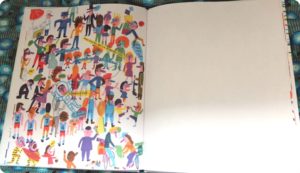
Tags: children's books, non-violence, people power, picture books, political change, reviews
Posted in Book Reviews, Peace | No Comments »
Saturday, March 19th, 2016
William Steig, (creator of Shrek) has been called ‘one of the finest cartoonists and creators of children’s books’ (Jonathan Cott). He began writing for children at 60 and his stories are often uncompromising but always celebrate the richness of relationships and nature. Steig used sophisticated language to entertain readers rather than befuddle them. 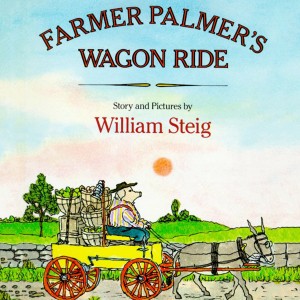
The picture book Farmer Palmer’s Wagon Ride is one of his most playful. A farmer-pig suffers a series of slapstick mishaps as he takes gifts home to his beloved family. I love his description of a rainstorm:
‘Harum-scarum gusts of wind … a drubbing deluge … thunder rambled and rumbled … it dramberamberoomed!’
Read the full article about William Steig and his books.
Tags: children's books, picture books, reviews, steig
Posted in Book Reviews, Children's Books, Humour | No Comments »
Sunday, January 3rd, 2016
The Thirteen Clocks, by James Thurber, is 60 years old and retains its brilliance. I can still recall whole sentences from when it was read to me as a child. This fairy tale parody, about a prince who performs impossible tasks to save a princess, uses every trick in the English language, including invented words ( ‘squtch’ and ‘zickering’). Look for the Ronald Searle illustrated version which has a bonus story, The Wonderful O, about a pirate who tries to ban the letter ‘o’. Here are some choice Thurber sentences:
Thorns grew thick and thicker in a ticking thicket of bickering crickets.
Time is for dragonflies and angels. The former live too little and the latter live too long.
A peasant in a purple smock stalked the smoking furrows, sowing seeds.
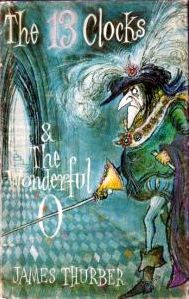
Tags: children's books, humour, reviews
Posted in Book Reviews, Children's Books, Humour | No Comments »
Thursday, December 10th, 2015
We should not write them off as superstitious primitives.– James Hannam
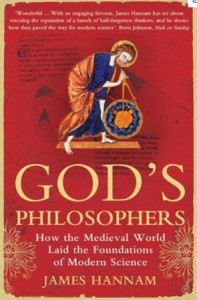 It’s a myth (turned cliche) that science and faith have always been at odds. The book, God’s Philosophers: How the Medieval World Laid the Foundations of Modern Science by James Hannam, shows how the church supported the genesis of science. Medieval universities were church-sponsored and ‘natural philosophy’ (as science was called back then) was a core subject. European thinkers drew on ancient Greek and Islamic texts to develop scientific principles that we still use today. Hannam debunks the myth of the ‘Dark Ages’: for example, people knew the Earth was round; the Christian church did not routinely persecute scientists; there were many inventions, from clocks to spectacles; and early Islamic scientists discovered how the eye functions and invented surgical instruments. (Essay on Science and Soul).
It’s a myth (turned cliche) that science and faith have always been at odds. The book, God’s Philosophers: How the Medieval World Laid the Foundations of Modern Science by James Hannam, shows how the church supported the genesis of science. Medieval universities were church-sponsored and ‘natural philosophy’ (as science was called back then) was a core subject. European thinkers drew on ancient Greek and Islamic texts to develop scientific principles that we still use today. Hannam debunks the myth of the ‘Dark Ages’: for example, people knew the Earth was round; the Christian church did not routinely persecute scientists; there were many inventions, from clocks to spectacles; and early Islamic scientists discovered how the eye functions and invented surgical instruments. (Essay on Science and Soul).
Tags: books, reviews, science
Posted in Book Reviews, Science | No Comments »
Sunday, November 29th, 2015
He who saves one life, it is as if he saved an entire world.– Babylonian Talmud
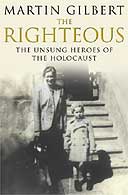 The Righteous by Martin Gilbert is a record of the very best and the very worst of human behaviour. These are remarkable stories of ‘Unsung Heroes of the Holocaust’ who risked their lives to save Jews during the 1940s. Schindler’s List is well known, but here are 500 similar acts of courage in helping Jews (which carried the death penalty in Nazi-occupied countries). Many of the stories come from the ‘Righteous Among the Nations’ archive which lists 19,000 non-Jews who risked their lives.
The Righteous by Martin Gilbert is a record of the very best and the very worst of human behaviour. These are remarkable stories of ‘Unsung Heroes of the Holocaust’ who risked their lives to save Jews during the 1940s. Schindler’s List is well known, but here are 500 similar acts of courage in helping Jews (which carried the death penalty in Nazi-occupied countries). Many of the stories come from the ‘Righteous Among the Nations’ archive which lists 19,000 non-Jews who risked their lives.
Anti-Semitism was rife in many parts of Europe and the Nazis were assisted by local populations in murdering tens of thousands of Jews, in addition to the concentration camps. The heroes in the book are clergy, farmers, businessmen, families, royalty, city officials, and soldiers. It’s estimated that to save one Jewish life required at least 10 people working in a fragile chain of courage.
Another remarkable book about saving Jewish lives in WW2 is Life in a Jar – The Irena Sendler Project by Jack Mayer. It’s the story of Irena Sendler who rescued 2,500 Jewish children in Nazi-occupied Poland – a forgotten piece of history uncovered by three high school girls in rural Kansas in 1999. Irena smuggled children out of the Warsaw ghetto where the Nazis imprisoned 450,000 Jews. The Kansas girls turned the story into a play which has had international impact.
This moment is the ultimate revenge on Hitler. Protestant kids, celebrating a Catholic rescuer of Jewish children for the Warsaw ghetto, performing in a Jewish theatre…and they are being filmed by German television.’ – Chief Rabbi of Poland
Posted in Book Reviews, Peace | No Comments »
Friday, November 6th, 2015
A Wrinkle in Time by Madeleine L’Engle was ahead of its time with its story of wormholes and angels. Struggling writers should take note that it was rejected 26 times because its ideas were so ground-breaking back in 1960. Not unlike the current Dr Who, L’Engle combined engaging characters with a sci-fi plot that invoked the whole universe – I especially love the ending where a giant disembodied alien brain is defeated by love. Here’s what she said about children’s books:
You have to write the book that wants to be written. And if the book will be too difficult for grown-ups, then you write it for children – Madeleine L’Engle
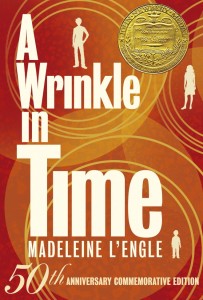
Tags: children's books, science fiction
Posted in Book Reviews, Children's Books, Sci-Fi | 1 Comment »
Friday, August 21st, 2015
Who was one of the most widely read but least known children’s authors? Carl Barks. My first comic book love was the Donald Duck series by Carl Barks who fleshed out Disney’s film characters and created 500 engrossing adventures for children. The hunt for square eggs in Lost in the Andes (1949) was a favourite and anything with the Italian sorceress, Magica de Spell . When I was ten I moved on to superhero comics – I loved the bizarre character Mr Mxyzptlk who could only be beaten if Superman tricked him into saying his name backwards. Why are comics so popular? Because the style combines dramatic art, fast pace and engaging characters. Teachers can use comics in class as models of design and tight narrative structure; and they’re ideal for reluctant readers, usually boys. The comic form also embraces stunning graphic novels for adults, such as Persepolis and Logicomix, about Bertrand Russell.
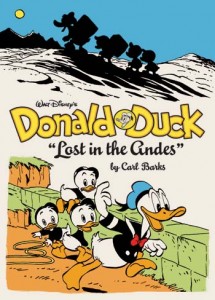
Tags: comics
Posted in Book Reviews | No Comments »






























 It’s a myth (turned cliche) that science and faith have always been at odds. The book, God’s Philosophers: How the Medieval World Laid the Foundations of Modern Science by James Hannam, shows how the church supported the genesis of science. Medieval universities were church-sponsored and ‘natural philosophy’ (as science was called back then) was a core subject. European thinkers drew on ancient Greek and Islamic texts to develop scientific principles that we still use today. Hannam debunks the myth of the ‘Dark Ages’: for example, people knew the Earth was round; the Christian church did not routinely persecute scientists; there were many inventions, from clocks to spectacles; and early Islamic scientists discovered how the eye functions and invented surgical instruments. (
It’s a myth (turned cliche) that science and faith have always been at odds. The book, God’s Philosophers: How the Medieval World Laid the Foundations of Modern Science by James Hannam, shows how the church supported the genesis of science. Medieval universities were church-sponsored and ‘natural philosophy’ (as science was called back then) was a core subject. European thinkers drew on ancient Greek and Islamic texts to develop scientific principles that we still use today. Hannam debunks the myth of the ‘Dark Ages’: for example, people knew the Earth was round; the Christian church did not routinely persecute scientists; there were many inventions, from clocks to spectacles; and early Islamic scientists discovered how the eye functions and invented surgical instruments. ( The Righteous
The Righteous
